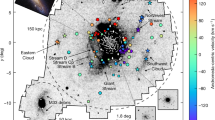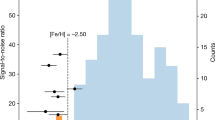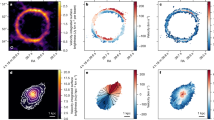Abstract
Massive galaxies in the young Universe, ten billion years ago, formed stars at surprising intensities1,2. Although this is commonly attributed to violent mergers, the properties of many of these galaxies are incompatible with such events, showing gas-rich, clumpy, extended rotating disks not dominated by spheroids1,2,3,4,5. Cosmological simulations6 and clustering theory6,7 are used to explore how these galaxies acquired their gas. Here we report that they are ‘stream-fed galaxies’, formed from steady, narrow, cold gas streams that penetrate the shock-heated media of massive dark matter haloes8,9. A comparison with the observed abundance of star-forming galaxies implies that most of the input gas must rapidly convert to stars. One-third of the stream mass is in gas clumps leading to mergers of mass ratio greater than 1:10, and the rest is in smoother flows. With a merger duty cycle of 0.1, three-quarters of the galaxies forming stars at a given rate are fed by smooth streams. The rarer, submillimetre galaxies that form stars even more intensely2,12,13 are largely merger-induced starbursts. Unlike destructive mergers, the streams are likely to keep the rotating disk configuration intact, although turbulent and broken into giant star-forming clumps that merge into a central spheroid4,10,11. This stream-driven scenario for the formation of discs and spheroids is an alternative to the merger picture.
This is a preview of subscription content, access via your institution
Access options
Subscribe to this journal
Receive 51 print issues and online access
$199.00 per year
only $3.90 per issue
Buy this article
- Purchase on Springer Link
- Instant access to full article PDF
Prices may be subject to local taxes which are calculated during checkout


 (r).
(r). 
 ).
). 
Similar content being viewed by others
References
Genzel, R. et al. The rapid formation of a large rotating disk galaxy three billion years after the Big Bang. Nature 442, 786–789 (2006)
Chapman, S. C., Smail, I., Blain, A. W. & Ivison, R. J. A population of hot, dusty ultraluminous galaxies at z ∼ 2. Astrophys. J. 614, 671–678 (2004)
Förster Schreiber, N. M. et al. SINFONI integral field spectroscopy of z ∼ 2 UV-selected galaxies: Rotation curves and dynamical evolution. Astrophys. J. 645, 1062–1075 (2006)
Genzel, R. et al. From rings to bulges: evidence for rapid secular galaxy evolution at z ∼ 2 from integral field spectroscopy in the SINS survey. Astrophys. J. 687, 59–77 (2008)
Stark, D. P. et al. The formation and assembly of a typical star-forming galaxy at z ≈ 3. Nature 455, 775–777 (2008)
Neistein, E., van den Bosch, F. C. & Dekel, A. Natural downsizing in hierarchical galaxy formation. Mon. Not. R. Astron. Soc. 372, 933–948 (2006)
Neistein, E. & Dekel, A. Merger rates of dark-matter haloes. Mon. Not. R. Astron. Soc. 388, 1792–1802 (2008)
Dekel, A. & Birnboim, Y. Galaxy bimodality due to cold flows and shock heating. Mon. Not. R. Astron. Soc. 368, 2–20 (2006)
Kereš, D., Katz, N., Weinberg, D. H. & Davé, R. How do galaxies get their gas? Mon. Not. R. Astron. Soc. 363, 2–28 (2005)
Noguchi, M. Early evolution of disk galaxies: Formation of bulges in clumpy young galactic disks. Astrophys. J. 514, 77–95 (1999)
Elmegreen, B., Bournaud, F. & Elmegreen, D. M. Bulge formation by the coalescence of giant clumps in primordial disk galaxies. Astrophys. J. 688, 67–77 (2008)
Wall, J. V., Pope, A. & Scott, D. The evolution of submillimetre galaxies: two populations and a redshift cut-off. Mon. Not. R. Astron. Soc. 383, 435–444 (2008)
Tacconi, L. J. et al. Submillimeter galaxies at z ∼ 2: Evidence for major mergers and constraints on lifetimes, IMF, and CO-H2 conversion factor. Astrophys. J. 680, 246–262 (2008)
Adelberger, K. L. et al. Optical selection of star-forming galaxies at redshifts 1 < z 3. Astrophys. J. 607, 226–240 (2004)
Daddi, E. et al. A new photometric technique for the joint selection of star-forming and passive galaxies at 1.4 < z 2.5. Astrophys. J. 617, 746–764 (2004)
Neistein, E. & Dekel, A. Constructing merger trees that mimic N-body simulations. Mon. Not. R. Astron. Soc. 383, 615–626 (2008)
Genel, S. et al. Mergers and mass accretion rates in galaxy assembly: The millennium simulation compared to observations of z ∼ 2 galaxies. Astrophys. J. 688, 789–793 (2008)
Birnboim, Y. & Dekel, A. Virial shocks in galactic haloes? Mon. Not. R. Astron. Soc. 345, 349–364 (2003)
Binney, J. On the origin of the galaxy luminosity function. Mon. Not. R. Astron. Soc. 347, 1093–1096 (2004)
Ocvirk, P., Pichon, C. & Teyssier, R. Bimodal gas accretion in the MareNostrum galaxy formation simulation. Mon. Not. R. Astron. Soc. 390, 1326–1338 (2008)
Keres, D. et al. Galaxies in a simulated ΛCDM Universe I: cold mode and hot cores. Preprint at 〈http://arxiv.org/abs/0809.1430〉 (2008)
Birnboim, Y., Dekel, A. & Neistein, E. Bursting and quenching in massive galaxies without major mergers or AGNs. Mon. Not. R. Astron. Soc. 380, 339–352 (2007)
Sheth, R. K. & Tormen, G. An excursion set model of hierarchical clustering: ellipsoidal collapse and the moving barrier. Mon. Not. R. Astron. Soc. 329, 61–75 (2002)
Kriek, M. et al. Spectroscopic identification of massive galaxies at z ∼ 2.3 with strongly suppressed star formation. Astrophys. J. 649, L71–L74 (2006)
van Dokkum, P. G. et al. Confirmation of the remarkable compactness of massive quiescent galaxies at z ∼ 2.3: Early-type galaxies did not form in a simple monolithic collapse. Astrophys. J. 677, L5–L8 (2008)
Cox, T. J., Jonsson, P., Somerville, R. S., Primack, J. R. & Dekel, A. The effect of galaxy mass ratio on merger-driven starbursts. Mon. Not. R. Astron. Soc. 384, 386–409 (2008)
Dekel, A. & Silk, J. The origin of dwarf galaxies, cold dark matter, and biased galaxy formation. Astrophys. J. 303, 39–55 (1986)
Dekel, A. & Woo, J. Feedback and the fundamental line of low-luminosity low-surface-brightness/dwarf galaxies. Mon. Not. R. Astron. Soc. 344, 1131–1144 (2003)
Dekel, A. & Birnboim, Y. Gravitational quenching in massive galaxies and clusters by clumpy accretion. Mon. Not. R. Astron. Soc. 383, 119–138 (2008)
Elmegreen, D. M., Elmegreen, B. G. & Hirst, A. C. Discovery of face-on counterparts of chain galaxies in the Tadpole Advanced Camera for Surveys Field. Astrophys. J. 604, L21–L23 (2004)
Robertson, B. E. & Bullock, J. S. High-redshift galaxy kinematics: Constraints on models of disk formation. Astrophys. J. 685, L27–L30 (2004)
Finlator, K., Davé, R., Papovich, C. & Hernquist, L. The physical and photometric properties of high-redshift galaxies in cosmological hydrodynamic simulations. Astrophys. J. 639, 672–694 (2006)
Nagamine, K., Ouchi, M., Springel, V. & Hernquist, L. Lyman-alpha emitters and Lyman-break galaxies at z = 3–6 in cosmological SPH simulations. Preprint at 〈http://arxiv.org/abs/0802.0228〉 (2008)
Acknowledgements
We acknowledge discussions with N. Bouche, S. M. Faber, R. Genzel, D. Koo, A. Kravtsov, A. Pope, J. R. Primack, J. Prochaska, A. Sternberg and J. Wall. This research was supported by the France–Israel Teamwork in Sciences, the German–Israel Science Foundation, the Israel Science Foundation, a NASA Theory Program at UCSC, and a Minerva fellowship (T.G.). We thank the Barcelona Centro Nacional de Supercomputación for computer resources and technical support. The simulation is part of the Horizon collaboration.
Author information
Authors and Affiliations
Corresponding author
Supplementary information
Supplementary Information
This file contains Supplementary Data, Supplementary Figures 1-9 with Legends and Supplementary References (PDF 1569 kb)
Rights and permissions
About this article
Cite this article
Dekel, A., Birnboim, Y., Engel, G. et al. Cold streams in early massive hot haloes as the main mode of galaxy formation. Nature 457, 451–454 (2009). https://doi.org/10.1038/nature07648
Received:
Accepted:
Issue Date:
DOI: https://doi.org/10.1038/nature07648
This article is cited by
-
Probing galaxy evolution through Hi 21-cm emission and absorption: current status and prospects with square kilometre array
Journal of Astrophysics and Astronomy (2022)
-
Quenching of star formation from a lack of inflowing gas to galaxies
Nature (2021)
-
The origin of galaxy colour bimodality in the scatter of the stellar-to-halo mass relation
Nature Astronomy (2021)
-
Running on fumes
Nature Astronomy (2021)
-
Chronos: A NIR spectroscopic galaxy survey to probe the most fundamental stages of galaxy evolution
Experimental Astronomy (2021)
Comments
By submitting a comment you agree to abide by our Terms and Community Guidelines. If you find something abusive or that does not comply with our terms or guidelines please flag it as inappropriate.



